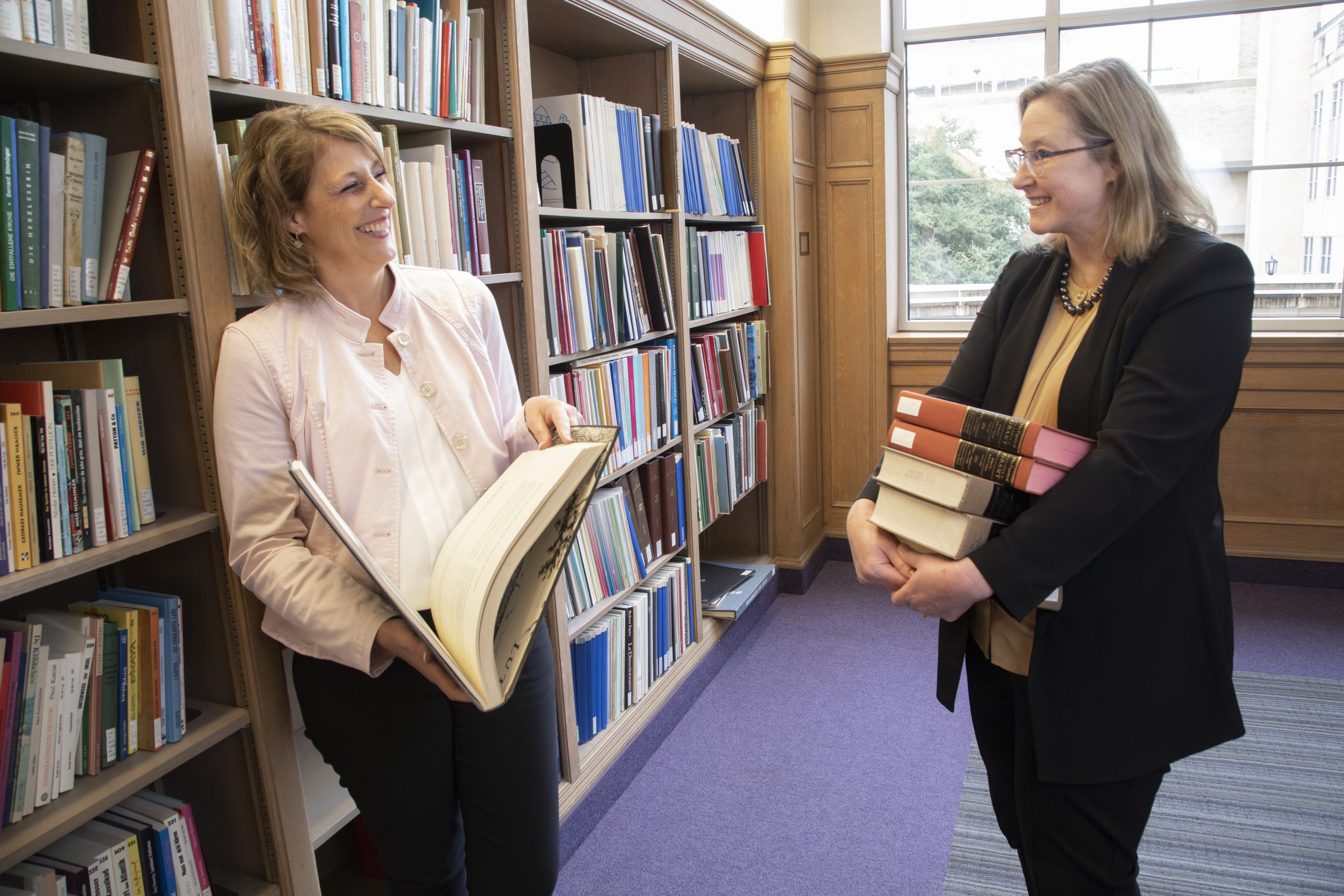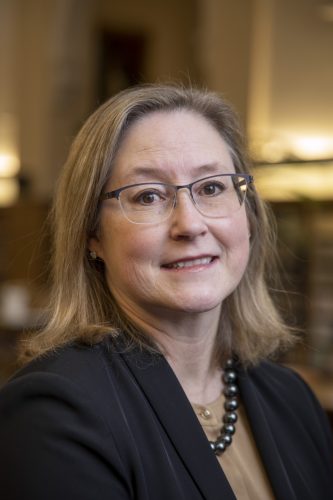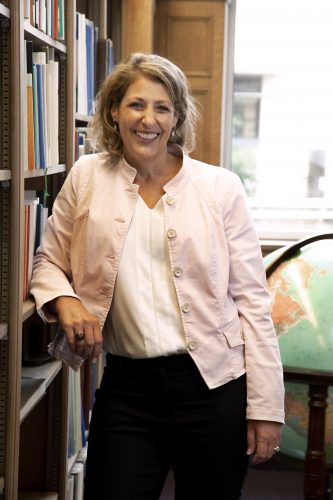New Textbook Gives Global Insight Into Teaching Literacy
Robin Griffith and Jan Lacina’s writing taps other cultures to teach literacy.

Robin Griffith and Jan Lacina co-edited the textbook Preparing Globally Minded Literacy Teachers: Knowledge, Practices and Case Studies (Routledge, 2020). Photo by Joyce Marshall
New Textbook Gives Global Insight Into Teaching Literacy
Robin Griffith and Jan Lacina’s writing taps other cultures to teach literacy.
A young girl named Unhei immigrates to the United States from South Korea. Eager to fit in with her new American classmates, she conceals her name for fear no one will be able to pronounce it. For a week, she tries adopting a new identity, going by Amanda, then Suzy, then Laura, but none feels right.
Unhei’s new friends encourage her to use her Korean name and ask her to teach them how to pronounce it — Yoon-hey.
This fictional story is included in a new textbook, Preparing Globally Minded Literacy Teachers: Knowledge, Practices and Case Studies (Routledge, 2020), co-edited by Jan Lacina and Robin Griffith.
Intended for kindergarten through eighth-grade literacy teachers, the textbook provides examples of how literacy is taught throughout the world, giving teachers an appreciation for different methods of instruction. Unhei’s story, told in Yangsook Choi’s picture book The Name Jar (Random House, 2003), is included in a chapter encouraging educators to use children’s literature as a tool for understanding different cultures.
“Through children’s literature, children can engage with characters from so many different backgrounds,” Lacina said. “They can learn empathy to others. They can learn about different life events, and I think personally the best way to teach is to expose children to a variety of cultures and how we are similar in so many ways and what we can learn from one another.”

Jan Lacina, professor and associate dean of graduate studies in TCU’s College of Education, has authored more than 100 papers on the topic of literacy. Photo by Joyce Marshall
Lacina, professor and associate dean of graduate studies in TCU’s College of Education, has built a career researching reading and writing instruction, authoring more than 100 papers and four books on the topic. In 2018, she was selected as the U.S. ambassador to the United Kingdom Literacy Association.
Griffith, professor of literacy education, studies early literacy teaching practices. With their similar areas of focus, Griffith and Lacina built a professional working relationship and soon started collaborating on a number of projects. “It helps that we are also good friends and colleagues, and we work really well together,” Lacina said. “I trust her and her opinion, and we support one another.”
Griffith and Lacina have served as co-editors of the International Literacy Association’s journal The Reading Teacher since 2015. In that role, they’ve sought to include more international perspectives on the review board to provide an expansive view of literacy instruction.
“I think globally minded teachers are always looking to learn more about their students and their students’ backgrounds,” Griffith said, “and are always looking to learn more about the greater world.”
The chapter authors represent a range of countries and education systems. “That is probably the greatest strength of the book,” Lacina said.
The textbook consists of three sections: Early Literacy, Intermediate to Adolescent Literacy and Case Studies. Chapters include “Becoming a Proficient Reader in Taiwan,” “Literacy Learning in the United Arab Emirates,” “Critical Literacy in South Africa” and “Improving Early Grade Literacy: Implementation of Mother Tongue Instruction Policy in Kenya.”
“The perspectives of these authors who are natives to their country, to their language, to the politics and the history can really bring to life for teachers around the world their perspectives and how the politics and the particular situation of the country influences the education of their children,” Lacina said.
The textbook promotes infusing classroom teaching with cultural sensitivities. That allows students to connect their personal lives and experiences to what they are learning about the broader context of society.

Robin Griffith, professor of reading and English in TCU’s College of Education, pulled from multicultural education strategies to co-edit a new textbook on literacy. Photo by Joyce Marshall
“Multicultural education looks like trying to understand individuals and how their home cultures, their cultures outside of school influence their understanding and their beliefs and their values — and celebrating that,” Griffith said.
One of the textbook chapters that explores this idea of how a home culture influences education is “Mensajes de los Abuelitos: Multimodal Zapotec Literacy Development Via the Assertion of Local Ontologies and Community-Based Xkialnana (Knowledge) in Oaxaca, Mexico: A Case Study,” co-authored by Steve Przymus, assistant professor of bilingual/multicultural education at TCU.
Przymus made a trip to Oaxaca, Mexico, where he observed the ways teachers attempted to incorporate elements of the region’s history and culture into the classroom by encouraging literacy of the traditional Zapotec language. Although the Mexican government requires Spanish to be the primary language of instruction, there is value in integrating a region’s native language and culture into an educational setting, Przymus said.
“A great community-based approach, valuing elders’ knowledge — that’s something that I don’t know how ubiquitous that is in the United States or other parts of the world,” said Przymus, who has stayed in touch with the Mexican educators. “And that’s something we definitely can learn from in this context.”
Lacina and Griffith began the textbook with a quote from Gandhi: “To reach real peace in the world, we will have to begin with the children.” They elaborate in the introductory chapter by explaining that “educating children encourages better understanding of others across the globe who may have different views, values and beliefs. Educating children helps them understand and learn from history, including the mistakes of the past as well as the successful moments in history.”
While the manner of instruction differs from chapter to chapter — for instance, the techniques and methods used to instruct affluent children at a private institution in Mexico City differ greatly from those for recently escaped refugees from North Korea attempting to learn English — the drive and passion for educating and shaping young lives through literacy development is a constant throughout the textbook.
“I think the care for children is universal as well as the importance of literacy, the importance of children having access to good literature,” Lacina said.

Your comments are welcome
Comments
Related reading:
Features
Comics in the Classroom Spark Creative Thinking
The medium itself breaks boundaries, and this idea transfers to course subject matter.
Research + Discovery
Understanding Literacy in Kids with Cochlear Implants
Even with hearing corrected, children may lag behind in language or reading comprehension.
Alumni, Features
Alumni Publish Books for Children
Whether through traditional publishing, crowdfunding or an independent local company, these writers followed their creativity to success.